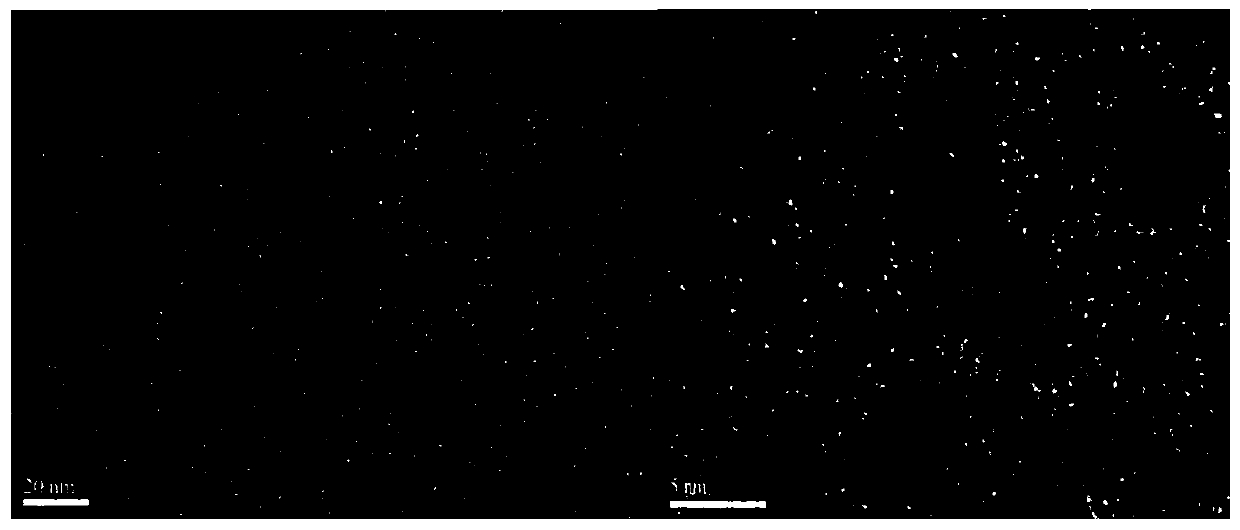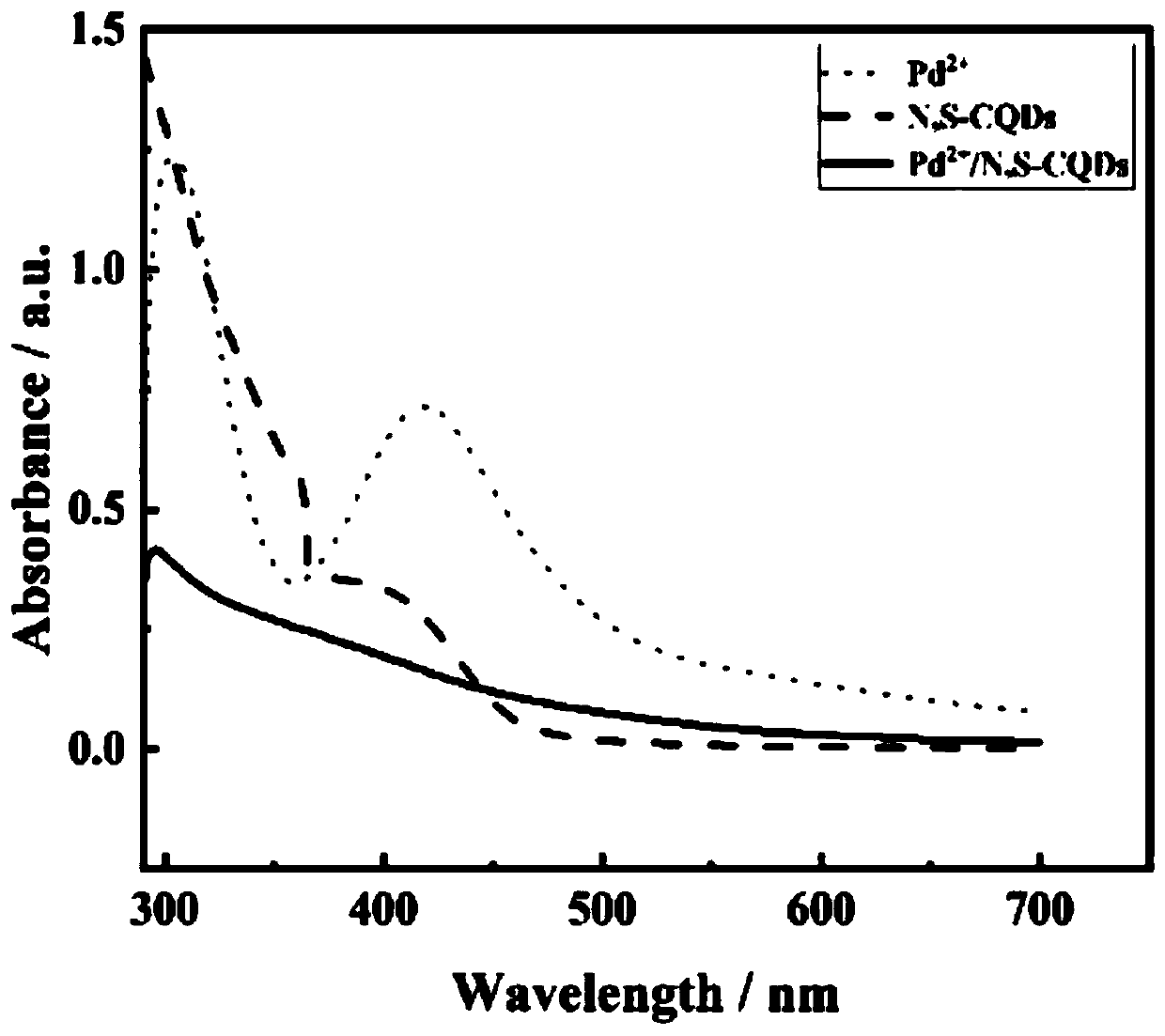Nitrogen-sulfur co-doped carbon quantum dot fluorescent probe for cysteine detection and preparation and application thereof
A technology of nitrogen-sulfur co-doping and fluorescent probes, applied in nanotechnology, measurement devices, fluorescence/phosphorescence, etc. for materials and surface science, can solve environmental hazards and other problems, achieve reduced interference and good reproducibility , the effect of strong signal response
- Summary
- Abstract
- Description
- Claims
- Application Information
AI Technical Summary
Problems solved by technology
Method used
Image
Examples
Embodiment 1
[0062] Preparation of water-soluble N,S-CQDs.
[0063] Such as figure 1 As indicated, 1.16mmol of 5,5'-dithiobis(2-nitrobenzoic acid) and 7.2mL of ethylenediamine were added to 40mL of deionized water, ultrasonicated for 10min, and then placed in a 100mL liner lined with polytetrafluoroethylene In an ethylene stainless steel autoclave (YZPR-100mL), heating was continued at 200°C for 12h, and then naturally cooled to room temperature to obtain a dark brown solution.
[0064] Use a 0.22 μm filter to remove larger particles in the dark brown solution, and then use a rotary evaporator (RE-52C) to concentrate the solution to 0.05 times the original volume.
[0065] The concentrated solution was purified by silica gel column chromatography, wherein deionized water was used as the eluent, and the green fluorescent solution was collected under the irradiation of a hand-held ultraviolet lamp (365 nm). Finally, the collected solution was heated at 110 °C for 8 h. The N,S-CQDs solid m...
Embodiment 2
[0070] Preparation of Pd 2+ / N,S-CQDs probe system.
[0071] Weigh 10 mg of the N,S-CQDs solid material prepared in Example 1, dissolve it in 100 mL of PBS buffer (pH 7.4, 10 mM), and sonicate for 10 min to obtain a N,S-CQDs solution with a concentration of 0.10 mg / mL.
[0072] Under the irradiation of UV light (365nm), the N,S-CQDs solution emits green fluorescence. The N,S-CQDs solution was detected using a fluorescence spectrophotometer.
[0073] Such as figure 1 As shown, the PdCl 2 PBS solution (50 μL 150 μM) was mixed with N,S-CQDs (20 μL 0.10 mg / mL) solution to prepare Pd 2+ / N,S-CQDs solution. Detected Pd 2+ / N, S-CQDs solution has no fluorescence under UV light irradiation.
[0074] For the same concentration of PdCl 2 solution, N,S-CQDs solution and Pd 2+ / N,S-CQDs were characterized by ultraviolet absorption spectroscopy, and the characterization results are as follows:
[0075] Such as image 3 As shown, it can be seen that PdCl 2 Overlapping with the ...
Embodiment 3
[0077](1) Add 20 μL of 0.1 mg / mL N,S-CQDs solution obtained in Example 2 into a 5 mL centrifuge tube, then dilute to 4 mL with PBS buffer (pH 7.4, 10 mM), stir rapidly for 10 seconds, and transfer to 4 mL In the cuvette, the fluorescent intensity is detected and recorded by a fluorometer, which is recorded as F 0 ;
[0078] (2) Take 13 5mL centrifuge tubes, add 20μL 0.1mg / mL N,S-CQDs solution respectively, and then add 0, 5, 10, 15, 20, 25, 30, 35, 40, 45, 50, 55, 60 μL of PdCl 2 Solution (150μM), then add PBS buffer solution to dilute to 4mL respectively, after stirring rapidly for 10s, measure and record the fluorescence intensity, the test results are as follows: Figure 5 As shown, it can be seen that when Pd 2+ When the solution concentration was in the range of 0-150 μM, the fluorescence intensity of N,S-CQDs increased with the increase of Pd 2+ decrease with increasing concentration;
[0079] (3) Pd 2+ The concentration was linearly fitted with the fluorescence in...
PUM
| Property | Measurement | Unit |
|---|---|---|
| concentration | aaaaa | aaaaa |
| particle size | aaaaa | aaaaa |
Abstract
Description
Claims
Application Information
 Login to View More
Login to View More - R&D
- Intellectual Property
- Life Sciences
- Materials
- Tech Scout
- Unparalleled Data Quality
- Higher Quality Content
- 60% Fewer Hallucinations
Browse by: Latest US Patents, China's latest patents, Technical Efficacy Thesaurus, Application Domain, Technology Topic, Popular Technical Reports.
© 2025 PatSnap. All rights reserved.Legal|Privacy policy|Modern Slavery Act Transparency Statement|Sitemap|About US| Contact US: help@patsnap.com



